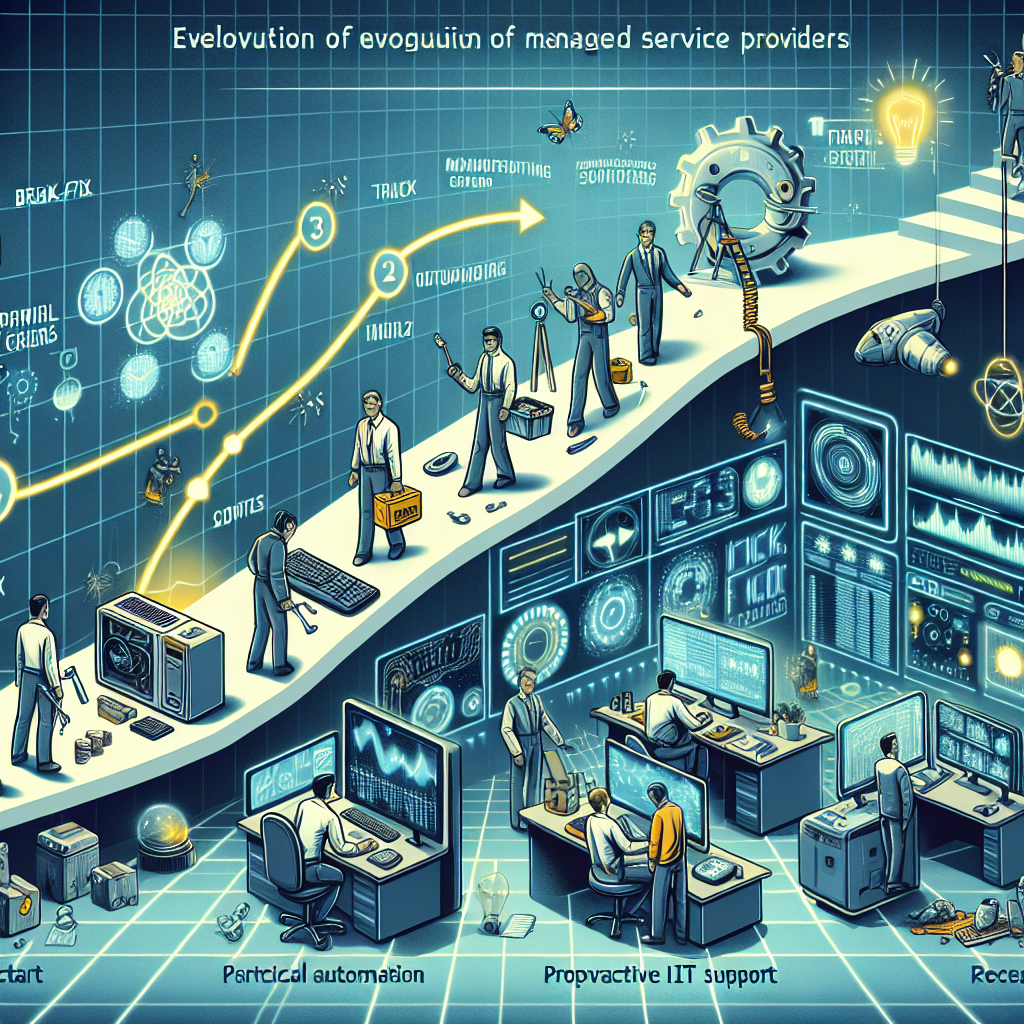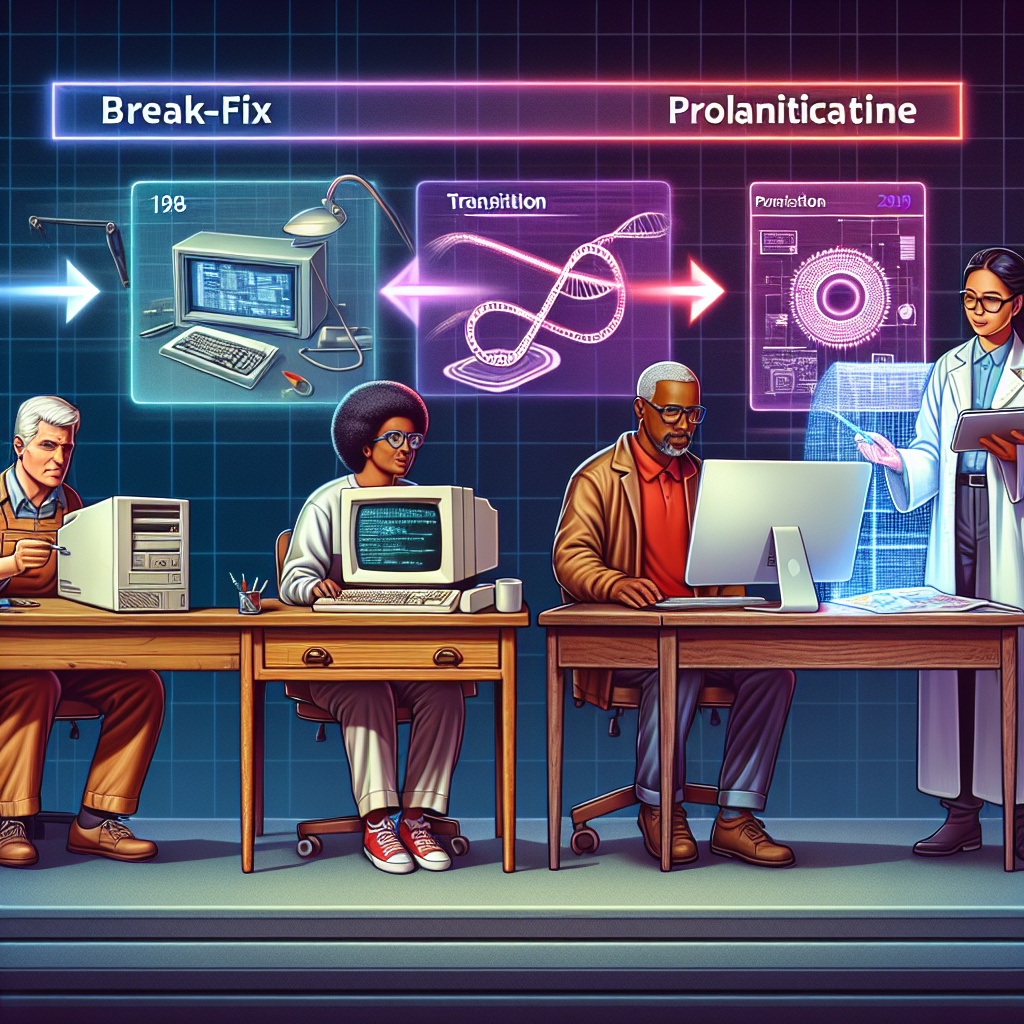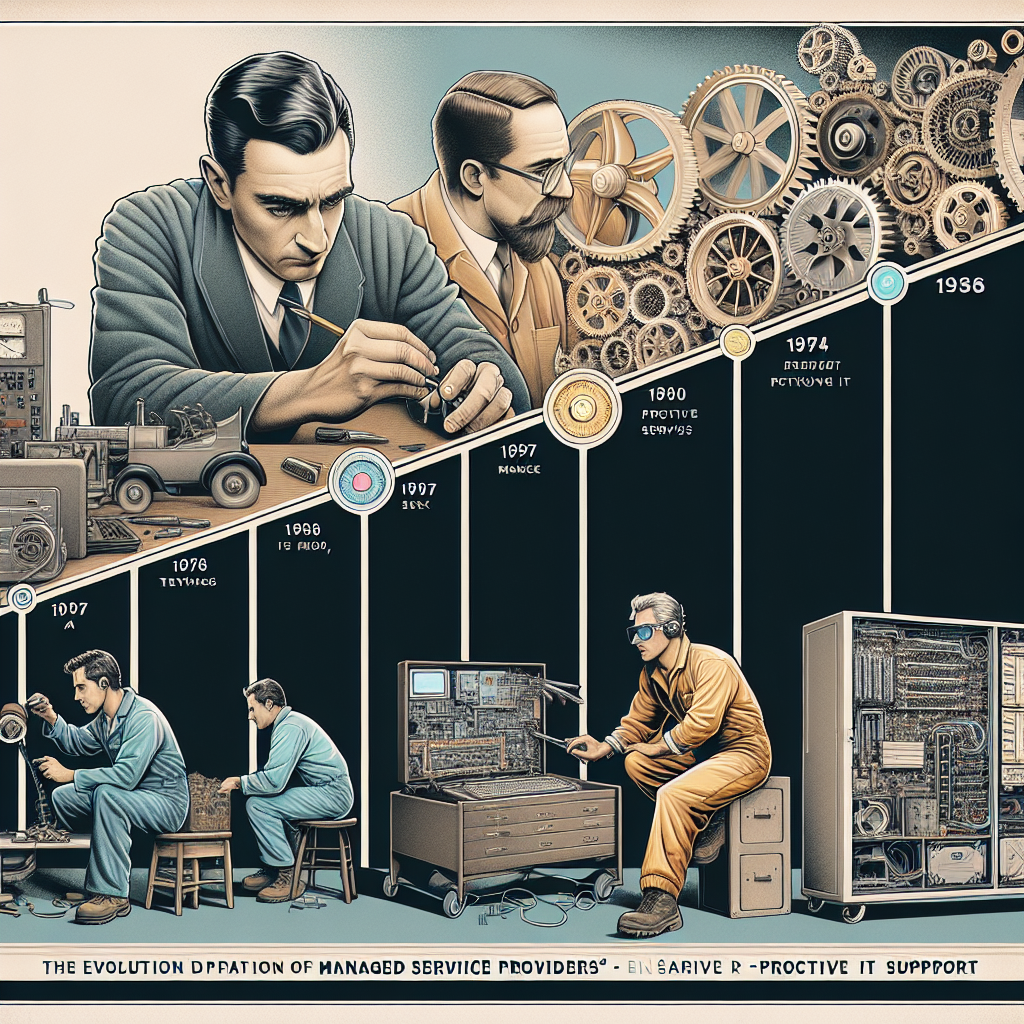Your cart is currently empty!
Tag: BreakFix

Managed Services vs. Break-Fix: Which is Right for Your Business?
In the world of IT support, businesses are often faced with the decision between managed services and break-fix solutions. Both options have their own pros and cons, so it’s important to weigh the benefits of each before making a decision.Managed services are a proactive approach to IT support. With a managed services provider (MSP), businesses pay a flat monthly fee for ongoing support and maintenance of their IT systems. This includes monitoring, troubleshooting, and resolving issues before they become major problems. Managed services also typically include regular updates and security patches to keep systems running smoothly and securely.
On the other hand, break-fix services are a reactive approach to IT support. With break-fix, businesses only pay for support when something goes wrong. This can be a cost-effective option for small businesses with limited IT needs, as they only pay for services as they are needed. However, break-fix services can also lead to longer downtime and higher costs when issues do arise.
So, which option is right for your business? It ultimately depends on your specific needs and budget. Here are a few factors to consider when making the decision:
1. Budget: Managed services typically have a higher upfront cost, as businesses are paying for ongoing support regardless of whether issues arise. Break-fix services, on the other hand, only require payment when support is needed. Consider your budget and how much you are willing to spend on IT support.
2. IT needs: If your business relies heavily on IT systems and downtime is not an option, managed services may be the better option. With proactive monitoring and maintenance, managed services can help prevent issues before they occur. However, if your IT needs are minimal and downtime is not a major concern, break-fix services may be a more cost-effective solution.
3. Scalability: Managed services are often more scalable than break-fix solutions, as businesses can easily add or remove services as needed. If your business is growing and you anticipate an increase in IT needs, managed services may be the better option to accommodate growth.
Ultimately, the decision between managed services and break-fix comes down to your specific needs and budget. Consider your IT requirements, budget constraints, and growth plans before making a decision. Whichever option you choose, it’s important to prioritize the security and reliability of your IT systems to ensure the success of your business.

From Break-Fix to Managed Services: How MSPs are Changing the IT Support Game
In the world of IT support, the traditional break-fix model is quickly becoming a thing of the past. Managed Service Providers (MSPs) are revolutionizing the way businesses handle their IT needs, offering a proactive approach to managing technology that is more efficient, cost-effective, and reliable than the old reactive break-fix model.The break-fix model, where IT support is only called in after a problem has already occurred, has long been the standard for many businesses. However, this approach can be costly and inefficient, as downtime from IT issues can result in lost productivity and revenue. Additionally, relying on a break-fix model means that businesses are constantly reacting to problems rather than preventing them from happening in the first place.
MSPs, on the other hand, take a proactive approach to IT support by monitoring and managing a company’s IT infrastructure on an ongoing basis. By using remote monitoring and management tools, MSPs can identify and address potential issues before they escalate into major problems. This proactive approach helps to minimize downtime, improve system performance, and increase overall productivity for businesses.
One of the key benefits of working with an MSP is the predictability of costs. With a break-fix model, businesses are often hit with unexpected expenses when IT issues arise. MSPs, on the other hand, typically offer fixed monthly pricing plans that include proactive monitoring, maintenance, and support services. This predictable pricing structure allows businesses to budget for their IT support needs more effectively and avoid costly surprises.
Another advantage of working with an MSP is access to a team of highly skilled IT professionals. MSPs employ technicians with a wide range of expertise in various technologies, allowing businesses to benefit from a depth of knowledge and experience that may not be available in-house. This expertise can be particularly valuable for small and medium-sized businesses that may not have the resources to hire a full-time IT staff.
Overall, the shift from break-fix to managed services represents a significant change in the way businesses approach IT support. By partnering with an MSP, businesses can enjoy a proactive, cost-effective, and reliable approach to managing their IT infrastructure that helps to drive efficiency, productivity, and growth. If you’re still relying on the outdated break-fix model for your IT support needs, it may be time to consider making the switch to managed services.

The Evolution of Managed Service Providers: From Break-Fix to Proactive IT Solutions
Managed Service Providers (MSPs) have come a long way since the early days of break-fix IT support. In the past, businesses would only call on IT support when something went wrong, resulting in costly downtime and lost productivity. However, as technology has evolved, so too have the services offered by MSPs.The shift from break-fix to proactive IT solutions has been driven by the increasing complexity of technology and the need for businesses to stay ahead of the curve. MSPs now offer a range of services designed to prevent issues before they occur, such as network monitoring, security audits, and regular software updates.
One of the key benefits of proactive IT solutions is the ability to predict and prevent problems before they impact the business. This not only reduces downtime and IT costs but also allows businesses to focus on their core operations without worrying about technical issues.
Another significant evolution in the MSP industry is the move towards cloud-based solutions. Cloud computing offers businesses greater flexibility, scalability, and cost-efficiency compared to traditional on-premise IT infrastructure. MSPs now offer a range of cloud services, including cloud storage, backup, and disaster recovery, to help businesses leverage the power of the cloud.
Furthermore, the rise of remote work has also shaped the services offered by MSPs. With more employees working from home, businesses need secure and reliable IT solutions to support their remote workforce. MSPs now offer remote monitoring and management services, as well as cybersecurity solutions to protect sensitive data from cyber threats.
Overall, the evolution of Managed Service Providers from break-fix to proactive IT solutions has been driven by the changing needs of businesses and advancements in technology. By partnering with an MSP, businesses can benefit from a range of services designed to keep their IT systems running smoothly and securely, allowing them to focus on their core operations and drive growth.

The Evolution of Managed Services: From Break/Fix to Proactive Maintenance
Managed services have come a long way since the days of break/fix IT support. In the past, companies would only call in IT support when something went wrong, leading to costly downtime and lost productivity. However, with the evolution of technology and the increasing complexity of IT systems, proactive maintenance has become the new standard in managed services.Proactive maintenance involves monitoring, managing, and maintaining IT systems on an ongoing basis to prevent issues before they occur. This shift from reactive to proactive maintenance has revolutionized the way businesses manage their IT infrastructure, leading to increased efficiency, reduced downtime, and improved overall performance.
One of the key benefits of proactive maintenance is the ability to identify and address potential issues before they become major problems. By continuously monitoring IT systems, managed service providers can detect early warning signs of hardware failures, software glitches, or security vulnerabilities and take corrective action before they escalate. This proactive approach not only minimizes downtime but also helps businesses avoid costly repairs and data loss.
Another advantage of proactive maintenance is its focus on optimization and performance improvement. Managed service providers can analyze data, identify trends, and make recommendations for optimizing IT systems to increase efficiency and productivity. This proactive approach ensures that businesses are getting the most out of their technology investments and staying ahead of the competition.
In addition to proactive maintenance, managed service providers also offer a range of other services to help businesses manage their IT infrastructure more effectively. These services may include network monitoring, security management, data backup and recovery, and software updates. By outsourcing these tasks to a managed service provider, businesses can free up internal resources, reduce costs, and focus on their core business activities.
Overall, the evolution of managed services from break/fix to proactive maintenance has transformed the way businesses manage their IT infrastructure. By taking a proactive approach to IT support, businesses can minimize downtime, improve performance, and stay ahead of the competition. With the increasing complexity of IT systems and the constant threat of cyber attacks, proactive maintenance has become essential for businesses of all sizes. If you haven’t already, now is the time to consider partnering with a managed service provider to take advantage of the benefits of proactive IT support.

The Evolution of Managed Service Providers: From Break/Fix to Proactive IT Support
Managed Service Providers (MSPs) have come a long way in the world of IT support. In the past, businesses would rely on a break/fix model, where they would only call in an IT provider when something went wrong with their systems. However, as technology has advanced and become more integral to everyday operations, the need for proactive IT support has become apparent.The evolution of MSPs from break/fix to proactive IT support can be attributed to several factors. One of the main reasons for this shift is the increasing complexity of technology. With the rise of cloud computing, mobile devices, and IoT, businesses are now dealing with a myriad of interconnected systems that require constant monitoring and maintenance. A break/fix approach simply cannot keep up with the demands of modern IT environments.
Another factor driving the evolution of MSPs is the growing importance of cybersecurity. With cyber threats becoming more sophisticated and prevalent, businesses need proactive measures in place to protect their data and systems. MSPs are now offering services such as network security assessments, threat monitoring, and incident response to help businesses stay ahead of potential security breaches.
Additionally, the shift towards proactive IT support can also be attributed to the changing expectations of businesses. In today’s fast-paced business environment, downtime is costly and can have a significant impact on a company’s bottom line. By proactively monitoring and maintaining systems, MSPs can help businesses prevent issues before they occur, minimizing downtime and maximizing productivity.
Overall, the evolution of MSPs from break/fix to proactive IT support is a positive development for businesses. By partnering with an MSP that offers proactive services, businesses can ensure that their systems are running smoothly and securely, allowing them to focus on their core business objectives. This shift towards proactive IT support is a testament to the ever-changing nature of technology and the importance of staying ahead of the curve in today’s digital world.

The Evolution of MSPs: From Break-Fix to Proactive Management
Managed Service Providers (MSPs) have come a long way since their inception in the IT industry. Originally, MSPs operated on a break-fix model, where they would only be called in to fix IT issues as they arose. However, as technology has evolved, so too have MSPs. Today, many MSPs offer proactive management services that focus on preventing issues before they occur.The break-fix model was a reactive approach to IT management. Businesses would only call in an MSP when something went wrong, such as a server crash or a security breach. This led to downtime, lost productivity, and often higher costs as businesses scrambled to fix the issue at hand. While break-fix services were effective at solving immediate problems, they were not a sustainable long-term solution for businesses that relied heavily on their IT infrastructure.
As technology became more complex and integral to business operations, the need for a more proactive approach to IT management became apparent. MSPs began to shift their focus towards preventing issues before they occurred, rather than simply reacting to them. This proactive management approach involves monitoring systems, identifying potential issues, and implementing solutions to prevent problems from arising in the first place.
Proactive management allows businesses to avoid costly downtime and disruptions to their operations. By constantly monitoring systems and addressing potential issues before they escalate, MSPs can help businesses maintain a stable and secure IT environment. This approach also allows businesses to plan and budget for their IT needs more effectively, as they can anticipate and address issues before they become critical.
In addition to preventing issues, proactive management also enables businesses to optimize their IT infrastructure for better performance and efficiency. MSPs can help businesses identify areas for improvement, implement new technologies, and streamline processes to make their IT systems more reliable and cost-effective. This proactive approach can help businesses stay ahead of the curve and adapt to the rapidly changing technology landscape.
Overall, the evolution of MSPs from break-fix to proactive management has been a game-changer for businesses of all sizes. By shifting their focus towards preventing issues rather than simply reacting to them, MSPs are able to provide more value to their clients and help them achieve their business goals more effectively. As technology continues to advance, proactive management will only become more essential for businesses looking to stay competitive in the digital age.

The Evolution of IT Consulting: From Break-Fix to Proactive Maintenance
The field of IT consulting has evolved significantly over the years, shifting from a reactive “break-fix” model to a more proactive approach focused on preventative maintenance and continuous improvement. This evolution has been driven by advancements in technology, changes in business needs, and a growing recognition of the importance of IT in driving business success.In the early days of IT consulting, the primary focus was on fixing problems as they arose. Clients would call in a consultant when something went wrong with their technology systems, and the consultant would come in to diagnose and repair the issue. This reactive approach was effective in addressing immediate problems, but it often led to downtime, lost productivity, and higher costs for businesses.
As technology became more complex and integrated into every aspect of business operations, the break-fix model became increasingly unsustainable. Businesses needed a more proactive approach to managing their IT systems in order to prevent problems before they occurred. This shift towards proactive maintenance was also driven by the growing recognition of the strategic importance of IT in driving business success. Companies began to see their technology systems as critical assets that needed to be managed and maintained in order to support their overall business goals.
Today, IT consulting firms offer a range of proactive maintenance services designed to keep clients’ systems running smoothly and efficiently. These services may include regular system monitoring and maintenance, security updates and patches, performance tuning, and strategic planning for future technology needs. By taking a proactive approach to IT maintenance, businesses can avoid costly downtime, improve productivity, and stay ahead of potential problems before they impact their operations.
In addition to proactive maintenance, modern IT consulting firms also offer strategic guidance and support to help businesses make informed decisions about their technology investments. Consultants work closely with clients to understand their business goals and challenges, and develop customized IT solutions that align with their needs. This strategic approach helps businesses leverage technology to drive innovation, improve efficiency, and gain a competitive edge in their industry.
Overall, the evolution of IT consulting from break-fix to proactive maintenance reflects the increasing importance of technology in modern business operations. By taking a proactive approach to managing their IT systems, businesses can minimize downtime, improve productivity, and achieve their strategic goals with the support of knowledgeable and experienced IT consultants. As technology continues to advance, IT consulting will continue to evolve to meet the changing needs of businesses and help them harness the power of technology for success.

The Evolution of Managed Service Providers: From Break-Fix to Proactive Maintenance
Managed Service Providers (MSPs) have come a long way since their inception, evolving from a break-fix model to proactive maintenance. In the early days of IT support, companies would only call on MSPs when something went wrong with their systems. This reactive approach to managing technology was costly and inefficient, as businesses would often experience downtime while waiting for their MSP to fix the issue.However, as technology became more complex and critical to business operations, the break-fix model became inadequate. Businesses needed a more proactive approach to managing their IT infrastructure in order to prevent issues before they occurred. This shift in mindset led to the emergence of proactive maintenance as a key service offering from MSPs.
Proactive maintenance involves actively monitoring and managing a company’s IT systems to prevent problems from arising in the first place. This includes regular maintenance tasks such as software updates, security patches, and system backups. By staying ahead of potential issues, MSPs can help businesses avoid costly downtime and ensure their systems are running smoothly at all times.
In addition to proactive maintenance, MSPs have also expanded their service offerings to include strategic IT planning and consulting. By working closely with their clients to understand their business goals and technology needs, MSPs can help companies develop a roadmap for their IT infrastructure that aligns with their overall business strategy. This proactive approach to IT management has become essential for businesses looking to stay competitive in today’s fast-paced digital landscape.
Overall, the evolution of MSPs from a break-fix model to proactive maintenance has been a game-changer for businesses of all sizes. By partnering with an MSP that offers proactive IT support, companies can ensure their systems are running smoothly, secure, and up-to-date, allowing them to focus on growing their business rather than dealing with technical issues. As technology continues to advance, the role of MSPs will only become more critical in helping businesses navigate the complex world of IT.

The Evolution of Managed Service Providers: From Break-Fix to Proactive Solutions
Managed Service Providers (MSPs) have come a long way since their inception in the 1990s. Originally, MSPs operated on a break-fix model, where they would only provide services when something went wrong with a client’s IT systems. However, as technology has evolved, so too have MSPs, transitioning from reactive solutions to proactive, strategic partnerships with their clients.The break-fix model was a common practice in the early days of MSPs. Clients would only contact their provider when they experienced a technical issue, such as a server crash or network outage. The MSP would then come in, fix the problem, and bill the client for the service. While this model worked for many businesses at the time, it was not sustainable in the long run.
As technology became more complex and integral to business operations, MSPs began to realize the limitations of the break-fix model. They understood that waiting for something to go wrong was not a proactive approach to managing IT systems. Instead, MSPs started to shift towards a proactive model, where they would monitor and maintain their clients’ systems on an ongoing basis to prevent issues from occurring in the first place.
This shift to proactive solutions has allowed MSPs to become true partners to their clients, offering a wide range of services beyond just troubleshooting technical issues. Today, MSPs provide services such as network monitoring, security management, data backup and recovery, and cloud computing solutions. They work closely with their clients to develop IT strategies that align with their business goals and help them stay ahead of the curve in a rapidly changing technological landscape.
One of the key benefits of working with a proactive MSP is the ability to prevent costly downtime and disruptions to business operations. By continuously monitoring and managing their clients’ IT systems, MSPs can identify and address potential issues before they escalate into major problems. This proactive approach not only saves businesses time and money but also helps them operate more efficiently and securely.
In addition to preventing issues, proactive MSPs also help their clients leverage technology to drive innovation and growth. By staying up-to-date on the latest trends and developments in the tech industry, MSPs can recommend and implement new solutions that improve productivity, streamline processes, and enhance the overall performance of a business.
Overall, the evolution of Managed Service Providers from break-fix to proactive solutions has been a game-changer for businesses of all sizes. By partnering with a proactive MSP, organizations can focus on their core business activities while leaving the management of their IT systems to experts who are dedicated to keeping them running smoothly and securely. As technology continues to advance, the role of MSPs will only become more vital in helping businesses navigate the complexities of the digital world.

The Evolution of Managed Service Providers: From Break-Fix to Proactive IT Support
Managed Service Providers (MSPs) have come a long way since their inception in the early 2000s. Initially, MSPs operated on a break-fix model, where clients would call them when something went wrong with their IT systems, and the MSP would come in to fix the issue. However, as technology has advanced and businesses have become more reliant on their IT infrastructure, the need for proactive IT support has become increasingly important. This has led to the evolution of MSPs from break-fix to proactive IT support.The break-fix model was a reactive approach to IT support, where MSPs would only be called in when there was a problem. This meant that businesses were often left waiting for issues to occur before they were addressed, leading to downtime and lost productivity. As technology became more complex and integral to business operations, this approach became unsustainable.
Proactive IT support, on the other hand, takes a preventative approach to managing IT systems. MSPs now monitor their clients’ systems 24/7, using advanced monitoring tools and automation to detect and resolve issues before they escalate into major problems. This proactive approach not only minimizes downtime but also helps to improve overall system performance and security.
The shift towards proactive IT support has been driven by several key factors. Firstly, the increasing complexity of IT systems means that businesses can no longer afford to wait for issues to occur before they are addressed. With the rise of cloud computing, mobile devices, and Internet of Things (IoT) devices, the potential attack surface for cyber threats has also expanded, making proactive security measures essential.
Secondly, businesses are increasingly demanding a more strategic approach to IT support. They want MSPs to not only fix problems when they occur but to also help them plan for the future and optimize their IT systems for maximum efficiency. Proactive IT support allows MSPs to become trusted advisors to their clients, helping them to align their IT strategy with their business objectives.
Finally, the evolution of MSPs from break-fix to proactive IT support has been enabled by advancements in technology. Monitoring tools and automation have made it easier for MSPs to detect and resolve issues in real-time, without the need for manual intervention. This has allowed MSPs to provide a higher level of service to their clients, while also reducing their own operational costs.
In conclusion, the evolution of Managed Service Providers from break-fix to proactive IT support has been driven by the increasing complexity of IT systems, the demand for a more strategic approach to IT support, and advancements in technology. Proactive IT support allows MSPs to provide a higher level of service to their clients, helping them to minimize downtime, improve system performance, and enhance security. As businesses continue to rely on their IT infrastructure for critical operations, proactive IT support will become increasingly important in ensuring their success.
